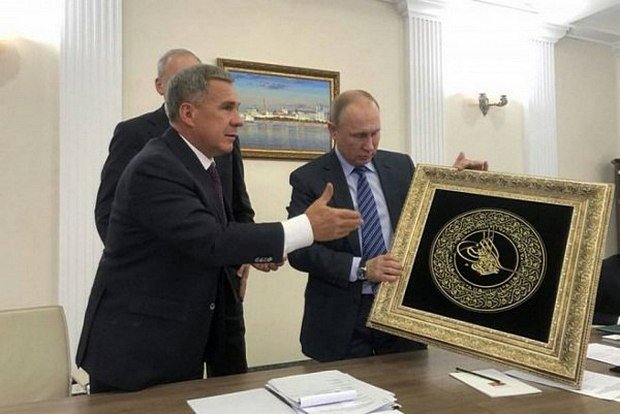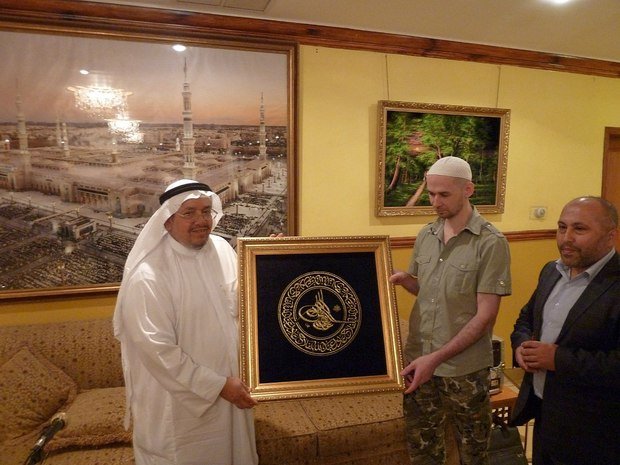''The full name of Vladimir Putin is written on the presented tughra''
Interview with Ramil Nasybullov, the calligrapher from Kazan
President of Russia Vladimir Putin has recently visited Kazan. After the meeting of the Russian leader with the muftis, Tatarstan President Rustam Minnikhanov presented to the guest a tughra — the symbol of the Ottoman rulers. This gift was made by a calligrapher from Kazan, Ramil Nasybullin. In the interview with Realnoe Vremya, the master told how he was ordered the gift for the president. He also told about what other high-ranking persons have his works and how he mastered the art of calligraphy.
To the Russian president — the symbol of the Ottoman rulers
Rustam Minnikhanov gave Vladimir Putin a tughra, made by your hands, as a present. Ramil khazrat, how did you get this job?
The idea to give a tughra as present came from rector of the Russian Islamic Institute Rafik Mukhametshin (he is also the rector of the Bolgarian Islamic Academy). There were no any special recommendations as I has many orders to make tughras from the RII to present them to the guests who visited the university, so they had some idea of how it would look like.
How much did it take to make the present for the president of Russia? What materials did you use?
The tughra is made on the basis of the canons of the science of writing as in the Muslim East calligraphy belongs to the category of both art and science, where even a degre in scholarship is required. It takes from 5 to 20 years to study some styles. After training, a special i'jaza (diploma) is given, and the person is included in the so-called silsilya — the chain of continuity in this science, leading from Ali ibn Abi Talib (the cousin of Muhammad, the prophet of Islam, and the fourth righteous caliph – editor's note). A person with this knowledge is called a hattat. Without i'jaza, a person has no right to sign.

''The presented tughra has the name, surname and patronymic name of Vladimir Vladimirovich Putin written on it.'' Photo: vk.com
Tughra is the special branch in classical calligraphy, the main feature of which was the creation of personal tughras for sultans, khans, shahs and other high-ranking persons. The tughra has a number of specifics in creation and writing. People who developed tughra were called tughrakeshas. It took about a month to prepare a high-quality tughra as it is necessary to do so that one form fitted in another like a puzzle, while not violating the canons of alphabetic forms, which is an extremely complex process. For example, let's suppose we make a tughra of four words that make up a name, and by lining up the words in a certain order, you reach the fourth word, but it doesn't fit the form. And in order to make the fourth word or part properly, it is necessary to re-build all over again. And ne have to do it for many times. The development of one tughra can take up to 200 variants before the tughra forming is completed. In other words, the tughra making is solving a puzzle with the difference that in solving the puzzle you know that it has the solution, but with the tughra it is not, it is impossible to suggest what result will be.
What is it written on the presidential tughra?
It is based on the form of the classical Ottoman tughra, which historically went through several stages of formation and achieved optimality in its form. Therefore, preference is given to this type of tughra. Until the early twentieth century, only Muslim rulers could have the tughra, but with disappearance of the khans, and later of the Ottoman Empire, it has lost its legal force, which led to the fact that now, if desired, any person can have it.
The presented tughra has the name, surname and patronymic name of Vladimir Vladimirovich Putin written on it. Besides, his full name is written in the canonical style of thuluth in a circle.
''Always winning''
Could you elaborate on what the tughra is?
Presumably, the word tughra etymologically comes from the word tugh. The tugh (flag, banner), according to historical data, represented itself a spear (pole) with horse tails attached to it. Perhaps, these were tribal, state symbols. In the tughra itself one can also find three vertical elements, called tughas, and the three diagonal elements — zulfas (zulfa — hair in Arabic).
The main part of the tughra is called kursi (throne), it was written with the name of sultan, the name of his father. If it is the tughra of the Ottoman rulers, it was also written with the title ''khan'', ''shah'' and the expression ''al-muzaffar daim'' — ''always winning''.

''Actually, I have made about more than 40 tughras in the Ottoman style for different people and with different social status, including presidents, government officials, muftis, teachers, ordinary citizens. <...> I don't remember everyone.'' Photo: vk.com
For what other high-ranking officials have you made tughras?
Actually, I have made about more thant 40 tughras in the Ottoman style for different people and with different social status, including presidents, government officials, muftis, teachers, ordinary citizens. Among them there are Mintimer Shaimiev, Rustam Minnikhanov, Dmitry Medvedev, presidents of Uzbekistan, Azerbaijan, Turkmenistan, Tajikistan, one of the sultans of Indonesia, a king of Saudi Arabia, as well as Rafik Mukhametshin, Kamil Iskhakov, several muftis: Kamil Samigullin, Ravil Gainutdin and others. I don't remember everyone.
Turkish teacher
Where and from whom did you learn to make paintings and the art of Arabic calligraphy?
Calligraphy is developed and made on special paper with special pen and ink because it is the basis of calligraphy. But the form of embroidery, engraving, etc. — this is purely technical tasks that have no relation to calligraphy, I'm not particularly engaged in the technical side.
Calligraphy is one of the directions I do, but it's not my main occupation. I do many Eastern arts, as well as historical reconstruction, Eastern music, making musical instruments, martial arts etc.
As for calligraphy, I started studying somewhere in 1989, and since 1993, thanks to my Turkish teacher Hasan Sevil, I started studying it professionally. In 1997, I got an i'jaza (diploma) in calligraphy in Turkey. I also have the second i'jaz in all styles of calligraphy (1997), and in canonical Oriental ornamentation and other arts.
What masters do you orient yourself to?
The orientation to masters is necessary at the beginning of training as it is the basic principle in comprehension of the science. If we are referring to the orientation to contemporary calligraphers, I do not do it and do not communicate with them because calligraphy is not my main occupation.